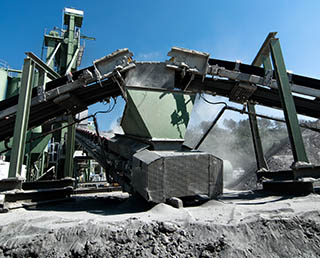Ready for Impact: Load Supports Play an Important Underlying Role in Belt Performance
May 8th, 2018
 Scenario 1: Your belt is running a pretty standard 6” minus coal. You’re prepared for that, right?
Scenario 1: Your belt is running a pretty standard 6” minus coal. You’re prepared for that, right?
Scenario 2: Two weeks later, that same belt sees a 300-lb mine ceiling slab fall onto it. Still prepared, or will your load support fail your system?
Just as one large pothole can compromise your car’s tire, one large rock can damage the load support, and consequently the belt, if material weight exceeds the design capacity. Truth is that belts and load supports see EVERY ounce of EVERY ton of product so protecting the belt in the load zone, even under unusual conditions, is critical to an efficient and working line.
Once in the impact area, there are several challenges to address to improve the load point, and every load zone needs attention to choosing the proper support of the belt. Let’s look at some of these load point challenges:
Load point improvement:
When selecting correct support of the belt, sometimes impact idlers, which stabilize the conveyor for smooth material conveyance, are sufficient. But, others may need a sophisticated impact bed that protects the belt from the force of large material lumps, to provide the required protection for the belt. You’ll need to identify your largest material lump weight and drop height, and calculate impact energy to determine which is your best solution.
Additional belt support considerations:
In other cases, there is not adequate support for the belt in the load area and there are underlying causes, in addition to not using impact idlers. These may include spacing impact idlers you do have too far apart, which creates gaps in the seal that can cause spillage or using catenary idlers that have too much “give,” resulting in an off-centered load and mistracking, causing damage and spillage down the line.
Materials contamination:
Escaping dust and spillage is a consideration for many lines, so you’ll need to appropriately seal the load zone from these contaminants with the appropriate belt support system.
Choosing Your Protection
With these considerations in mind, you want to ensure the belt is continuously supported. If you select an impact bed instead of an impact idler, check and recheck the specifications before selecting a model. As mentioned earlier, you need to identify the largest lump size and drop height (distance from the top of the feeding conveyor to the receiving belt) and multiply them together. The result, expressed in lb-ft, will be your estimated impact energy. Once you have this information, make sure your solution’s ratings are not lower than the impact force.
At Flexco, we always remind customers that the success of any conveyor solution is dependent on several different areas of the system, and an entire system evaluation greatly benefits all operations. Our goal is to maximize your efficiency and productivity and make things as easy as possible for your success.
Authored By: Kevin Fales, Product Manager
Fales manages the belt conveyor product (BCP) line, providing product development and engineering with guidance on market requirements for both new product concepts and existing products. He also leads the development of technical and promotional literature supporting BCP line. Fales graduated from Grand Valley State University with a bachelor’s degree in Marketing and is currently working toward his master’s degree in business administration from Western Michigan University.
Subscribe to the Flexco Blog
Related Blogs
Published Date
May 08, 2018Product Group
- Impact Beds and Skirting Systems
Issue
- Belt Protection